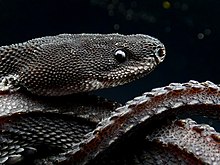Xenodermus javanicus, also known as the dragon snake, Javan tubercle snake, Javan mudsnake, or rough-backed litter snake,[1][2][3] is a small non-venomous, semi-fossorial snake species belonging to the monotypic genus Xenodermus.[4] This species is best known for their characteristic dorsal scales and interesting defense mechanism in which they stiffen their entire bodies when threatened. X. javanicus is nocturnal and subsists on a diet of frogs, tadpoles and small fish.[5] They most often perish once placed into captivity; only a few herpetoculturists have been successful in keeping them.
| Xenodermus | |
|---|---|

| |
| Scientific classification | |
| Domain: | Eukaryota |
| Kingdom: | Animalia |
| Phylum: | Chordata |
| Class: | Reptilia |
| Order: | Squamata |
| Suborder: | Serpentes |
| Family: | Xenodermidae |
| Genus: | Xenodermus Reinhardt, 1836 |
| Species: | X. javanicus
|
| Binomial name | |
| Xenodermus javanicus Reinhardt, 1836
| |
Distribution and habitat
editXenodermus javanicus is found in the Malay Peninsula (Malaysia, Thailand, and one old record from the southernmost tip of Myanmar) and parts of the Greater Sunda Islands (Sumatra, Java, and Borneo, as well as some smaller islands).[1][2] It inhabits damp areas near water, including forests, swamps, marshes, and rice fields, at elevations below 1,300 m (4,300 ft), but most commonly between 500–1,100 m (1,600–3,600 ft) above sea level.[1]
Description
editXenodermus javanicus has a distinct head and long tail. The body is slender and compressed. The total length is about 50 cm (20 in).[6][7] Males can be distinguished from females by examining the overall size, tail thickness, tail length, and cloacal vent for the presence of a hemipenial bulge: Females will be larger than males; have thinner, shorter tails, and lack a hemipenial bulge. Conversely, males will be smaller in comparison, have thicker, longer tails and exhibit a hemipenial bulge.[5]
Differentiation of sex chromosomes and karyotype characterization
editXenodermus javanicus has an unusual chromosomal number of 2n = 32 , contrasting with the most typical snake karyotype with a stable chromosomal number of 2 n = 36 . The karyotype includes heteromorphic ZZ/ZW sex chromosomes with a heterochromatic W.[9]
Behavior
editBreeding
editXenodermus javanicus undergo reproduction by egg and have low fecundity (2–4 eggs).[1][2]
Activity pattern
editXenodermus javanicus are nocturnal.[5]
Diet
editXenodermus javanicus subsist mainly on frogs, tadpoles, and small fish.[5]
Behaviors
editXenodermus javanicus exhibit a peculiar property when encountering perceived threats in which they stiffen their entire body to defend themselves. They may also emit a foul-smelling odour called a musk.[3][5]
Conservation status
editXenodermus javanicus are rare in the northern parts of their range, but are common in Java. There seem to be no major threats to them, and they can persist in wet agricultural lands such as rice fields. They could be potentially threatened by agricultural pollutants.[1]
References
edit- ^ a b c d e f Wogan, G.; Grismer, L.; Chan-Ard, T. (2012). "Xenodermus javanicus". IUCN Red List of Threatened Species. 2012: e.T190514A1954501. doi:10.2305/IUCN.UK.2012-1.RLTS.T190514A1954501.en. Retrieved 19 November 2021.
- ^ a b c Xenodermus at the Reptarium.cz Reptile Database. Accessed 2 July 2020.
- ^ a b Durso, Andrew M. (10 September 2013). "Dragonsnakes" (blog). Life is short, but snakes are long. Retrieved 2 July 2020.
- ^
"[no title cited]". Bulletin of the Raffles Museum (12–14): 172–173. 1936. Retrieved 16 August 2013.[failed verification]
Kopstein, F. (1938). "Ein Beitrag zur Morphologie, Biologie und Ökologie von Xenodermus javanicus Reinhardt" [A contribution to the morphology, biology and ecology of Xenodermus javanicus (Reinhardt, 1836)]. Bulletin of the Raffles Museum (in German) (14): 168–174. Retrieved 4 May 2024 – via Internet Archive (archive.org). — Found article possibly intended. - ^ a b c d e Nightshade, Scarlett. "Dragon snake care guide". Creatures of Nightshade (creaturesofnightshade.com). Retrieved 26 September 2020.
- ^ de Rooij, Nelly (1917). The Reptiles of the Indo-Australian Archipelago. Vol. II. Ophidia with 117 illustrations. Brill Archive. pp. 44–45. Retrieved 16 August 2013.
- ^ Lum, Steven (14 January 2022). "Dragon snake: Does it exist for real? Yes! Is dragon snake venomous?". Journeying the Globe (journeyingtheglobe.com). Retrieved 14 January 2022.
- ^ Nightshade, Scarlett. Dragon snake scalation. Creatures of Nightshade (photograph). Retrieved 26 September 2020.
- ^ Rovatsos, Michail; Johnson Pokorná, Martina; Kratochvíl, Lukáš (2015). "Differentiation of sex chromosomes and karyotype characterisation in the dragonsnake Xenodermus javanicus (Squamata: Xenodermatidae)". Cytogenetic and Genome Research. 147 (1): 48–54. doi:10.1159/000441646. PMID 26575989. S2CID 20902555.
